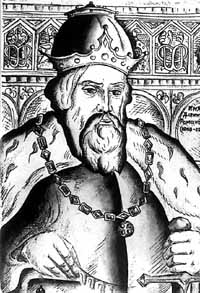Danylo’s Crown?

In the last ten years many myths, or, pardon me, rather versions for serious historians, have been disseminated in the already independent Ukraine: about St. Andrew visiting Ukraine, or Hetman Pavlo Polubotok’s treasures waiting for his assignees in some British bank.
Here is one more, probably not so hot, sensation. Polish historian Jevgeny Misylo reported to a scientific conference in Lviv, dedicated to the 800th anniversary of the sovereign of Halych-Volodymyr land, Prince Danylo Romanovych, on his investigation of the case of prince’s crown.
Let us turn to history. Danylo Romanovych (1201-1264) was prince of Volyn and Halych. After his father’s death in 1205 he together with his brother Vasylko fought determinedly against boyar opposition and came to the Halych throne only in 1238, uniting the Halych and Volyn lands. In 1239-1240 Danylo even was Kyiv’s sovereign, but Mongol Khan Batu’s hordes’ invasion thwarted his plans. However, Prince Danylo conducted an active foreign policy throughout his life, defeating his neighbors: the Hungarians, Lithuanians, Poles, and Teutonic knights. He also sought allies among the Northern Rus’ princes to fight against the Tatars.
The most contradictory event in prince’s life that still arouses doubts, since there are no established facts or written sources to confirm it, was his accepting a royal crown from Pope Innocent IV in Dorohochyn (Pidlashshia) in 1253. There are some indirect indications to this effect, but the version is still unsteady. Mykhailo Hrushevsky in his Illustrated History of Ukraine (Kyiv-Lviv, 1913) after telling about Prince Danylo’s negotiations with Pope’s legate (Opizo?) gives a most interesting footnote, “We encounter this story in later records; we have no contemporary evidence of the Pope’s contacts with Roman (Danylo’s father —Author). Perhaps there were some contacts, but we do not know whether the Pope really promised the crown to Roman” (p.125).
In any case, this version, or idea, is to everybody’s taste (say, there had always been representatives of the royal power in Ukraine!), flattering our compatriots’ vanity. However, Italian registrars have not so far helped us to get at the truth. Even if this episode really took place, it did not contribute to strengthening the state power in Halych and Volyn. As Hrushevsky writes further, “The Pope could not be of any help; instead he encouraged converting to Catholicism, that is, change everything in the Orthodoxy that differed from it, and in order to get Danylo his promised royal crown” (p.125).
In the opinion of one of the leading specialists in Kyiv Rus’ and medieval history in Ukraine, Ph.D. in history Mykola Kotliar, it was not a crown but a diadem (a golden strip with denticles, like the one kings on card wear), which at that time the Pope gave to sovereigns whose rank was lower than a king. Incidentally, there were about forty such diadems made. Mr. Kotliar also believes that St. Andrew did not even come to the Black Sea coast and restricted his missionary activity to Asia Minor.
Meanwhile Jevgeny Misylo, supporting the version that the crown was transformed into the Przemysl Greek Catholic bishops’ miter in the nineteenth century, keeps searching for it in the Warsaw Basilian Monastery (the scheme according to which it can be found is supposed to be somewhere in the Polish Security archives). As we know, the precious bishop’s miter has been sought since World War II. Indeed, this relic is worth scholars’ attention, but does it make any sense to create a new myth about the alleged crown of the Halych and Volyn noble prince, who in any case occupies an honorable place in the Pantheon of Ukraine’s founding fathers?






